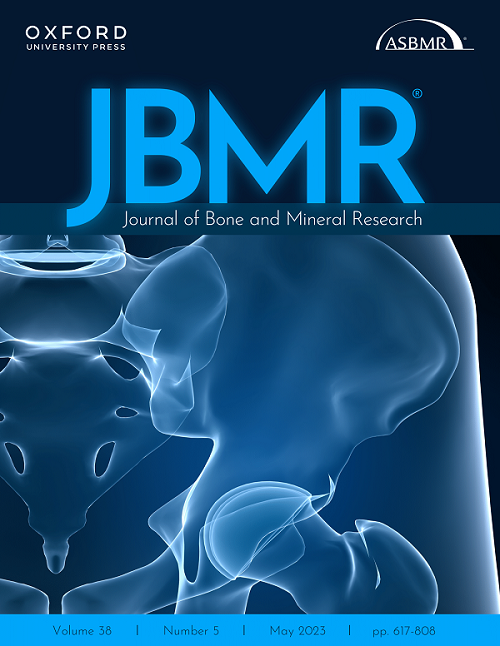Melanie Haffner-Luntzer, Deniz Ragipoglu, Mubashir Ahmad, Astrid Schoppa, Lena Steppe, Verena Fischer, Julia Luther, Timur Yorgan, Ernesto Bockamp, Michael Amling, Thorsten Schinke, Anita Ignatius
下载PDF
{"title":"Wnt1 Boosts Fracture Healing by Enhancing Bone Formation in the Fracture Callus","authors":"Melanie Haffner-Luntzer, Deniz Ragipoglu, Mubashir Ahmad, Astrid Schoppa, Lena Steppe, Verena Fischer, Julia Luther, Timur Yorgan, Ernesto Bockamp, Michael Amling, Thorsten Schinke, Anita Ignatius","doi":"10.1002/jbmr.4797","DOIUrl":null,"url":null,"abstract":"<p>Despite considerable improvement in fracture care, 5%–10% of all fractures still heal poorly or result in nonunion formation. Therefore, there is an urgent need to identify new molecules that can be used to improve bone fracture healing. One activator of the Wnt-signaling cascade, Wnt1, has recently gained attention for its intense osteoanabolic effect on the intact skeleton. The aim of the present study was to investigate whether Wnt1 might be a promising molecule to accelerate fracture healing both in skeletally healthy and osteoporotic mice that display a diminished healing capacity. Transgenic mice for a temporary induction of Wnt1 specifically in osteoblasts (Wnt1-tg) were subjected to femur osteotomy. Non-ovariectomized and ovariectomized Wnt1-tg mice displayed significantly accelerated fracture healing based on a strong increase in bone formation in the fracture callus. Transcriptome profiling revealed that Hippo/yes1-associated transcriptional regulator (YAP)-signaling and bone morphogenetic protein (BMP) signaling pathways were highly enriched in the fracture callus of Wnt1-tg animals. Immunohistochemical staining confirmed increased activation of YAP1 and expression of BMP2 in osteoblasts in the fracture callus. Therefore, our data indicate that Wnt1 boosts bone formation during fracture healing via YAP/BMP signaling both under healthy and osteoporotic conditions. To further test a potential translational application of Wnt1, we applied recombinant Wnt1 embedded into a collagen gel during critical-size bone-defect repair. Mice treated with Wnt1 displayed increased bone regeneration compared to control mice accompanied by increased YAP1/BMP2 expression in the defect area. These findings are of high clinical relevance because they indicate that Wnt1 could be used as a new therapeutic agent to treat orthopedic complications in the clinic. © 2023 The Authors. <i>Journal of Bone and Mineral Research</i> published by Wiley Periodicals LLC on behalf of American Society for Bone and Mineral Research (ASBMR).</p>","PeriodicalId":185,"journal":{"name":"Journal of Bone and Mineral Research","volume":"38 5","pages":"749-764"},"PeriodicalIF":5.1000,"publicationDate":"2023-03-09","publicationTypes":"Journal Article","fieldsOfStudy":null,"isOpenAccess":false,"openAccessPdf":"https://onlinelibrary.wiley.com/doi/epdf/10.1002/jbmr.4797","citationCount":"0","resultStr":null,"platform":"Semanticscholar","paperid":null,"PeriodicalName":"Journal of Bone and Mineral Research","FirstCategoryId":"3","ListUrlMain":"https://onlinelibrary.wiley.com/doi/10.1002/jbmr.4797","RegionNum":1,"RegionCategory":"医学","ArticlePicture":[],"TitleCN":null,"AbstractTextCN":null,"PMCID":null,"EPubDate":"","PubModel":"","JCR":"Q1","JCRName":"ENDOCRINOLOGY & METABOLISM","Score":null,"Total":0}
引用次数: 0
引用
批量引用
Abstract
Despite considerable improvement in fracture care, 5%–10% of all fractures still heal poorly or result in nonunion formation. Therefore, there is an urgent need to identify new molecules that can be used to improve bone fracture healing. One activator of the Wnt-signaling cascade, Wnt1, has recently gained attention for its intense osteoanabolic effect on the intact skeleton. The aim of the present study was to investigate whether Wnt1 might be a promising molecule to accelerate fracture healing both in skeletally healthy and osteoporotic mice that display a diminished healing capacity. Transgenic mice for a temporary induction of Wnt1 specifically in osteoblasts (Wnt1-tg) were subjected to femur osteotomy. Non-ovariectomized and ovariectomized Wnt1-tg mice displayed significantly accelerated fracture healing based on a strong increase in bone formation in the fracture callus. Transcriptome profiling revealed that Hippo/yes1-associated transcriptional regulator (YAP)-signaling and bone morphogenetic protein (BMP) signaling pathways were highly enriched in the fracture callus of Wnt1-tg animals. Immunohistochemical staining confirmed increased activation of YAP1 and expression of BMP2 in osteoblasts in the fracture callus. Therefore, our data indicate that Wnt1 boosts bone formation during fracture healing via YAP/BMP signaling both under healthy and osteoporotic conditions. To further test a potential translational application of Wnt1, we applied recombinant Wnt1 embedded into a collagen gel during critical-size bone-defect repair. Mice treated with Wnt1 displayed increased bone regeneration compared to control mice accompanied by increased YAP1/BMP2 expression in the defect area. These findings are of high clinical relevance because they indicate that Wnt1 could be used as a new therapeutic agent to treat orthopedic complications in the clinic. © 2023 The Authors. Journal of Bone and Mineral Research published by Wiley Periodicals LLC on behalf of American Society for Bone and Mineral Research (ASBMR).
Wnt1通过促进骨折痂骨形成促进骨折愈合
尽管骨折护理有了相当大的改善,但仍有5%-10%的骨折愈合不良或导致骨不愈合。因此,迫切需要发现可用于促进骨折愈合的新分子。wnt信号级联的一个激活因子Wnt1最近因其对完整骨骼的强烈骨合成代谢作用而受到关注。本研究的目的是研究Wnt1是否可能是一种有希望的分子,可以加速骨骼健康和骨质疏松小鼠的骨折愈合能力下降。在成骨细胞中暂时特异性诱导Wnt1的转基因小鼠(Wnt1-tg)进行股骨截骨。未切除卵巢和未切除卵巢的Wnt1-tg小鼠显示出明显加速骨折愈合,这是基于骨折痂骨形成的强烈增加。转录组分析显示,Hippo/yes1相关转录调节因子(YAP)信号通路和骨形态发生蛋白(BMP)信号通路在Wnt1-tg动物的骨折愈伤组织中高度富集。免疫组化染色证实骨折愈伤组织成骨细胞中YAP1的激活和BMP2的表达增加。因此,我们的数据表明,在健康和骨质疏松的情况下,Wnt1通过YAP/BMP信号促进骨折愈合过程中的骨形成。为了进一步测试Wnt1的潜在翻译应用,我们将重组Wnt1嵌入胶原凝胶中,用于临界大小的骨缺损修复。与对照组小鼠相比,经Wnt1处理的小鼠显示出骨再生增加,同时缺损区域YAP1/BMP2表达增加。这些发现提示Wnt1在临床上可作为一种新的治疗骨科并发症的药物,具有很高的临床意义。©2023作者。由Wiley期刊有限责任公司代表美国骨与矿物研究协会(ASBMR)出版的骨与矿物研究杂志。
本文章由计算机程序翻译,如有差异,请以英文原文为准。

 求助内容:
求助内容: 应助结果提醒方式:
应助结果提醒方式:


